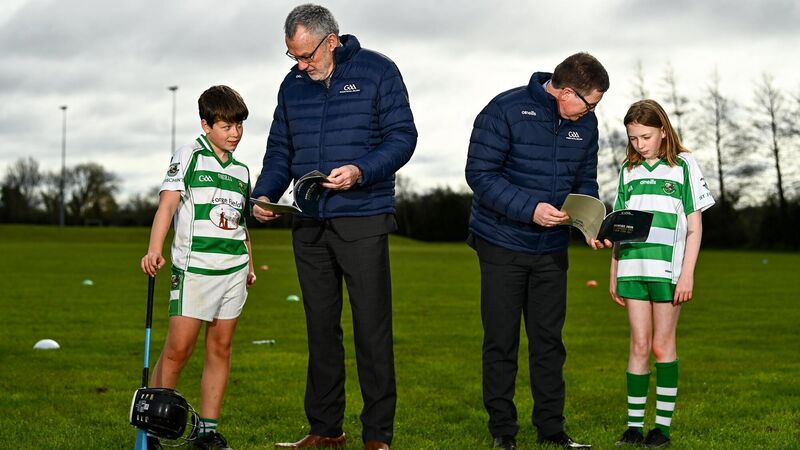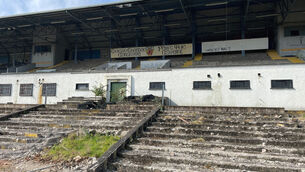Paul Rouse: Words alone will not shape the GAA's future

Uachtarán Chumann Lúthchleas Gael Larry McCarthy and Ard Stiúrthóir of the GAA Tom Ryan with St Fechin's Gaa juvenille players Tom Riley and Isobel Walsh during GAA National Strategy Launch at St Fechin’s GAA Club in Termonfeckin, Louth. Photo by Eóin Noonan/Sportsfile
The real challenge with any strategic plan has very little to do with its research and writing. In many respects, coming up with ideas for improvement and committing them to paper in such a way that it can be presented as a plausible vision of the future is relatively straightforward. Not exactly easy in terms of the work involved, but relatively straightforward in its setting out.
But, too often, a strategic plan stands as an end in itself. There is an understandable reality to this: It is the product of hour after hour of work to get a document ready to launch and this is draining.
The thing is, any person who has been a part of any organisation or institution that has created a strategic plan understands that it is in the weeks, months and then years after the publication of the plan that the real work starts.
This is where the stamina demanded to give meaning to plans reveals itself. And too often, it reveals itself by the absence of implementation.
When it comes down to it, the essential ingredient of every strategic plan is a practical plan for its implementation. Without such a plan, there is ordinarily no prospect of meaningful progress.
In the GAA’s new strategic plan (‘Aontas 2026 - Towards One GAA for All’), published this week, the Director General Tom Ryan writes: “This is not a straitjacket that the GAA must conform to and fit into. It deliberately leaves scope to be flexible and nimble when the needs arises and we have learnt from similar previous projects when societal changes dramatically altered targets and circumstances.”
And in its articulation of the GAA’s purpose, vision and values, there is much to admire in the strategic plan. It imagines the best version of what the GAA could and should be in a clear way.
The central idea that has grabbed the attention in respect of this strategic plan is the creation of an Association where men and women – and their games – are equal.
To this end, in his introductory piece on the strategic plan, the GAA president Larry McCarthy foregrounded the intention to draw together the GAA, the LGFA and the Camogie Association in one organisation (as well as handball and rounders).
This is set out in short in four simple words: “Six codes, One Association.” Elaborating on this, McCarthy writes of the “intention as an organisation to come together with the members of the GAA family and align our activities.” This idea of integration makes sense and is to be wished well. But there is a clear acknowledgement of the challenges involved in this process in McCarthy’s next sentence when he writes: “It is a signal of the direction we hope to take.” But, again, it is through practical actions that visions are realised.
What are the sequence of practical actions that are set out in this document that will allow the desired direction be followed to achieve the “Six codes, One Association” goal?
This is where things get more than a little tricky. The strategic plan maps out broad implementation procedures for all the recommendations in the report. They are:
1. Establish a Strategic Plan Implementation Committee chaired by the GAA President which will meet on a quarterly basis;
2. Review progress with the Management Committee and Staff Executive on a regular basis;
3. Encourage all Committees to review and revise their Terms of Reference to align with this strategic plan;
4. Hold regular meetings of Central Committee Chairpersons to review progress and opportunities for cross-functional collaboration:
5. Incentivise each Department, Provincial Council, and County Committee to produce annual action plans outlining how they propose to align with and support the implementation of the Association’s strategy;
6. Produce an annual update on progress via the Ard-Stiúrthóir’s Report to Congress;
7. Produce a mid-term review in 2024.
This does not feel like enough. In terms of the integration with the LGFA and the Camogie Association alone, there is a huge amount of work to be done. Quarterly meetings of a “Strategic Plan Implementation Committee” does not seem adequate. “Regular meetings” and words such as “incentivise” and “encourage” are vague in detail and open to drift.
It may very well be that the energy and drive and determination of the officials who are running the GAA will allow them to deliver results within this frame, but it is certainly not set out in the Strategic Plan how this will work.
Perhaps the space that they are creating in setting out this vision will allow for momentum to gather – or be created – that will make a reality of the vision that is set out.
But when you drill down into the detail around integration, it makes plain just how much of the road remains to be travelled: “1. Explore viable integration structures in conjunction with the LGFA, Camogie Association, Handball Association, and Rounders Association;
2. Produce a shared vision for One Association and roadmap to make it happen;
3. Continue to streamline operations programmes such as the Player Pathway and explore solutions to critical issues.”
This is not so much a plan as a set of aspirations. And this is where we get back to the matter of implementation.
Towards the end of his piece in the strategic report, Larry McCarthy writes: “Strategy … is fundamentally about choices.”
He is absolutely right about that.
Because all the choices that are to be made by the GAA in the coming years will demand resources. This is not just a matter of money, but also one of human resources and the commitment of volunteers.
And that one aspect of the plan alone – the formation of “One Association” – is going to cost a lot of money and hour upon hour of commitment to achieve real equality.
Again, to be clear, it is of fundamental importance that this equality should be achieved. The strategic plan gives no indication, however, as to how it might actually happen.
What matters is what happens next. How soon will the implementation committee meet? Can it gather momentum? Is there the clarity of purpose and drive within the GAA to make this happen?
The first significant point of reckoning will come with the promised update on progress via the Annual Report to Congress. It will have become clear by then when this strategic report is to be taken seriously or not. And whether it can be relevant to what the GAA says it wishes to become.








